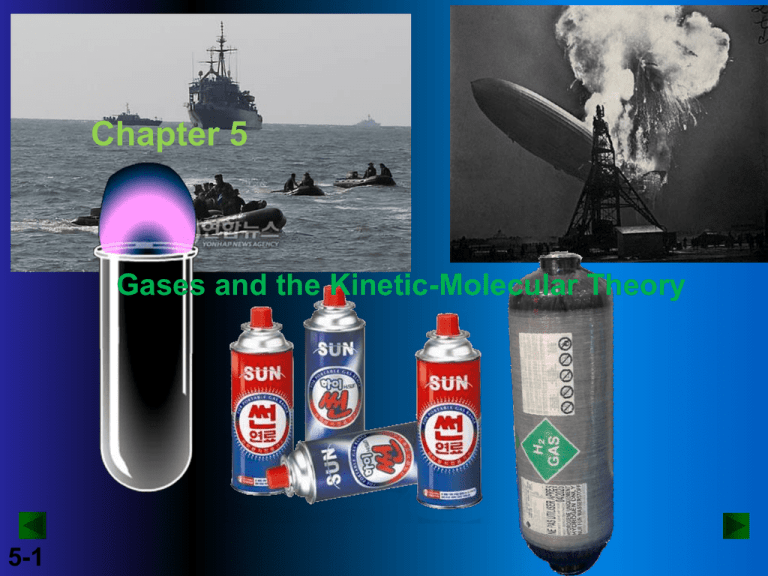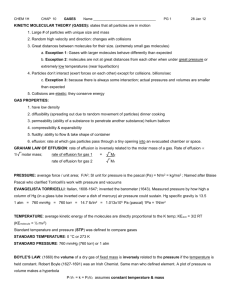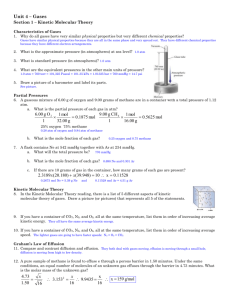Document
advertisement

Chapter 5 Gases and the Kinetic-Molecular Theory 5-1 기체와 분자운동론 • 기체상태의 물질 • 기체의 압력 • 기체 법칙 보일의 법칙, 샤를의 법칙, 아보가드로의 법칙 • 분압 • 기체분자운동론 온도와 에너지, 확산 • 실제기체 및 반데르발스 상태방정식 5-2 Gases and the Kinetic Molecular Theory 5.1 An Overview of the Physical States of Matter 5.2 Gas Pressure and Its Measurement 5.3 The Gas Laws and Their Experimental Foundations 5.4 Further Applications of the Ideal Gas Law 5.5 The Ideal Gas Law and Reaction Stoichiometry 5.6 The Kinetic-Molecular Theory: A Model for Gas Behavior 5.7 Real Gases: Deviations from Ideal Behavior 5-3 기체는 왜 공부하는가? 역사적인 배경과 의미 1. Boyle’s Law – First Scientific Experiment, 1661 2. Charles’s Law – Definition of Temperature, 1780s 3. Avogadro’s Hypothesis – 4. Combined Ideal Gas Law and Kinetic Theories– First Successful Scientific Law derived from purely mathematical approach. 실용적인 배경과 의미 1. 기체는 열역학의 기초, 열역학 제1, 2 법칙을 설명 2. 화학 평형, 화학적 퍼텐셜의 기초 3. 화학반응의 근본적 이해를 도움- 반응동력학 5-4 Physical Characteristics of Gases Gases assume the volume and shape of their containers. Gases are the most compressible state of matter. Gases will mix evenly and completely when confined to the same container. Gases have much lower densities than liquids and solids. 5-5 Force Pressure = Area (force = mass x acceleration) Units of Pressure 1 pascal (Pa) = 1 N/m2 1 atm = 760 mmHg = 760 torr 1 atm = 101,325 Pa bar = 105 Pa 5-6 psi = lb/in2 = 6894.757 Pa Barometer 5-7 PRESSURE Units and Measurement Pressure = Force/Area SI Units Force = mass × acceleration Force = kg-m/s2 = Newton Pressure = Newton/m2 = Pascal Customary Units Pressure = atm, torr, mmHg, bar, psi Relate SI to customary 1.01325 × 105 Pascal = 1 atm = 760 torr bar = 105 Pascal 5-8 Common Units of Pressure Unit Atmospheric Pressure Scientific Field pascal(Pa); 1.01325×105Pa; SI unit; physics, chemistry atmosphere(atm) 1 atm* chemistry mm of mercury(Hg) 760 mm Hg* chemistry, medicine, biology torr 760 torr* chemistry 14.7 psi engineering 1.01325 bar meteorology, chemistry, physics pounds per square inch (psi or lb/in2) bar *This is an exact quantity; in calculations, we use as many significant figures as necessary. 5-9 Boyle’s Law(1662) 𝑝𝑉 = 𝑘 5-10 Charles’ Law (1780s) Definition of Temperature V = V0 + at V = aT 0 5-11 Temperature(K) 273.15 T (K) = t (0C) + 273.15 Avogadro’s Hypothesis Equal volumes of gases contain the same number of molecules at constant T,P 22.414 L of any gas contains 6.022×1023 atoms (or molecules) at 0 ℃ and 1 atm. 5-12 Avogadro’s Law(1811) V ∝ number of moles (n) V = constant × n Constant temperature Constant pressure V1/n1 = V2/n2 3 H2(g) + N2(g) → 2 NH3(g) 5-13 3 volume + 1 volume → 2 volume 3 mol + 1 mol → 2 mol 3 molecules + 1 molecule → 2 molecules Ideal Gas Equation 1 Boyle’s law: V ∝ (at constant n and T) 𝑃 Charles’ law: V ∝ T (at constant n and P) Avogadro’s law: V ∝ n (at constant P and T) V∝ 𝑛𝑇 𝑃 V= 𝑛𝑇 constant× 𝑃 =R 𝑛𝑇 𝑃 R is the gas constant PV = nRT 5-14 Dalton’s Law of Partial Pressures V and T : constant P1 5-15 P2 Ptotal = P1 + P2 Consider a case in which two gases, A and B, are in a container of volume V. nART PA = V nA is the number of moles of A nBRT PB = V nB is the number of moles of B PT = PA + PB PA = XA PT nA XA = nA + nB PB = XB PT Pi = xi PT 5-16 nB XB = nA + nB mole fraction (xi) = ni nT The Molar Mass of a Gas 𝑚𝑎𝑠𝑠 𝑃𝑉 𝑛= = 𝑀 𝑅𝑇 𝑚𝑅𝑇 𝑀= 𝑉𝑃 𝑚 𝑑= 𝑉 𝑑𝑅𝑇 𝑀= 𝑃 5-17 Water Vapor Pressure Table Temperature (°C) 0.0 5.0 10.0 12.5 15.0 15.5 16.0 16.5 17.0 17.5 18.0 18.5 19.9 5-18 Pressure (mmHg) 4.6 6.5 9.2 10.9 12.8 13.2 13.6 14.1 14.5 15.0 15.5 16.0 16.5 Temperature (°C) 19.5 20.0 20.5 21.0 21.5 22.0 22.5 23.0 23.5 24.0 24.5 25.0 26.0 Pressure (mmHg) 17.0 17.5 18.1 18.6 19.2 19.8 20.4 21.1 21.7 22.4 23.1 23.8 25.2 Temperature (°C) 27.0 28.0 29.0 30.0 35.0 40.0 50.0 60.0 70.0 80.0 90.0 95.0 100.0 Pressure (mmHg) 26.7 28.3 30.0 31.8 42.2 55.3 92.5 149.4 233.7 355.1 525.8 633.9 760.0 T (°C) 0 1 2 3 4 5 6 7 8 9 10 11 12 13 14 15 16 17 18 19 20 21 22 23 24 25 5-19 Pressure (mmHg) 4.6 4.9 5.3 5.7 6.1 6.5 7.0 7.5 8.0 8.6 9.2 9.8 10.5 11.2 12.0 12.8 13.6 14.5 15.5 16.5 17.5 18.7 19.8 21.1 22.4 23.8 T (°C) Pressure (mmHg) 26 27 28 29 30 31 32 33 34 35 36 37 38 39 40 41 42 43 44 45 46 47 48 49 50 25.2 26.7 28.3 30.0 31.8 33.7 35.7 37.7 39.9 42.2 44.6 47.1 49.7 52.4 55.3 58.3 61.5 64.8 68.3 71.9 75.7 79.6 83.7 88.0 92.5 T (°C) Pressure (mmHg) T (°C) Pressure (mmHg) 51 52 53 54 55 56 57 58 59 60 61 62 63 64 65 66 67 68 69 70 71 72 73 74 75 97.2 102.1 107.2 112.5 118.0 123.8 129.8 136.1 142.6 149.4 156.4 163.8 171.4 179.3 187.5 196.1 205.0 214.2 223.7 233.7 243.9 254.6 265.7 277.2 289.1 76 77 78 79 80 81 82 83 84 85 86 87 88 89 90 91 92 93 94 95 96 97 98 99 100 301.4 314.1 327.3 341.0 355.1 369.7 384.9 400.6 416.8 433.6 450.9 468.7 487.1 506.1 525.8 546.0 567.0 588.6 610.9 633.9 657.6 682.1 707.3 733.2 760.0 stoichiometric relationships among the amount (mol,n) of gaseous reactant or product and the gas variables P, V, and T. P,V,T of gas A ideal gas law amount (mol) amount (mol) P,V,T of gas A of gas B of gas B molar ratio from balanced equation 3 H2(g) + N2(g) → 2 NH3(g) 5-20 ideal gas law Kinetic Molecular Theory of Gases 1. A gas is composed of molecules that are separated from each other by distances far greater than their own dimensions. The molecules can be considered to be points; that is, they possess mass but have negligible volume. d(N2,g) = 0.00125 g/L (273°C) d(N2,liq) = 0.808 g/mL (-195.8°C) 2. Gas molecules are in constant motion in random directions. Collisions among molecules are perfectly elastic. 3. Gas molecules exert neither attractive nor repulsive forces on one another.(no interaction) 5-21 V a Avogadro’s Law n Ek = 1/2 mass x u 2 Ek = 1/2 mass x speed2 u 2 is the root-mean-square speed urms = √3RT R = 8.314Joule/mol*K M Graham’s Law of Effusion The rate of effusion of a gas is inversely related to the square root of its molar mass. rate of effusion a 5-22 1 √M Applying Graham’s Law of Effusion PROBLEM: Calculate the ratio of the effusion rates of helium and methane (CH4). PLAN: The effusion rate is inversely proportional to the square root of the molar mass for each gas. Find the molar mass of both gases and find the inverse square root of their masses. SOLUTION: M of CH4 = 16.04g/mol rate He rate 5-23 CH4 = √ 16.04 4.003 = 2.002 M of He = 4.003g/mol Figure 5.18 Diffusion of a gas particle through a space filled with other particles. distribution of molecular speeds mean free path collision frequency 5-24 Molar Volume of Some Common Gases at 00C and 1 atm Gas He H2 Ne Ideal gas Ar N2 O2 CO Cl2 NH3 5-25 Molar Volume (L/mol) 22.435 22.432 22.422 22.414 22.397 22.396 22.390 22.388 22.184 22.079 Condensation Point (0C) -268.9 -252.8 -246.1 ---185.9 -195.8 -183.0 -191.5 -34.0 -33.4 Figure 5.19 The behavior of several real gases with increasing external pressure. 5-26 Van der Waals Constants for Some Common Gases Van der Waals equation for n moles of a real gas n2a (P 2 )(V nb) nRT V adjusts P up adjusts V down a Gas He Ne Ar Kr Xe H2 N2 O2 Cl2 CO2 CH4 NH3 H2O 5-27 atm·L2 mol2 0.034 0.211 1.35 2.32 4.19 0.244 1.39 1.36 6.49 3.59 2.25 4.17 5.46 b L mol 0.0237 0.0171 0.0322 0.0398 0.0511 0.0266 0.0391 0.0318 0.0562 0.0427 0.0428 0.0371 0.0305 Collisions of Gas Particles 5-28 Collisions of Gas Particles 5-29 The gas molecules in the container are in random motion 5-30 압력과 기체분자 운동 • 운동량 변화 ∆p = mvx – (–mvx) = 2mvx • 분자의 왕복시간 ∆t = 2a/vx • 분자 한 개가 면 A에 미치는 힘 f = ∆p/ ∆t= 2mvx/(2a/vx)= mvx2/a • N개의 분자에 의해 면 A에 가해지는 압력 • P = Σf/a2 = m(vx12 + vx22 + ... + vxN2)/a3 =Nmvx2/V PV=Nmvx2 5-31 압력과 기체분자 운동 • 공간 상에서 무작위로 움직이는 분자는 특별한 방향에 대한 선호도가 없을 것이므로 v x v y v z v 2 v x v x v x 3v x 2 2 2 2 2 2 1 2 vx v 3 2 1 2 1 2 2 PV Nmv x Nmv N ( mv ) 3 3 2 2 Gas Pressure in the Kinetic Theory 분자당 평균운동에너지 5-32 KE 1 2 mv 2 2 운동에너지와 온도 PV • 1 2 1 Nmv 2 N ( mv 2 ) 3 3 2 이상 기체방정식 PV nRT • 기체에 열이 가해지면 기체의 내부에너지와 온도가 증가! 1 2 3 mv k BT 2 2 R kB 1.38 10 23 J/K NA KE 5-33 Mean Kinetic Energy per particle Boltzmann constant 1 1 2 PV Nmv nM v 2 3 3 v2 urms PV = NkBT = nRT 3k BT 3RT m M 3k BT 3RT v2 m M N = number of molecules, kB = Boltzmann constant, J K-1, n = number of moles = N/NA, R = gas constant, 0.08204 l atm mol-1 K-1 T = temperature, P = gas pressure, V = volume, NA = Avogadro’s number 5-34 Maxwell-Boltzmann Distribution for Molecular Speeds u~ u+du 사이의 속도를 가진 분자들의 수 m f(u) 2πkT 3/ 2 2 mu 4πu 2 exp( ) 2kT f(u) = speed distribution function, m = molecular mass, k = Boltzmann constant, T = temperature, u = speed 5-35 분자속도와 에너지 분포 (Molecular velocity and energy distribution) • 슈테른(Otto Stern)의 분자속도 측정 노벨물리학상 수상자(1943, w/ Gerlach) Schematic diagram of a stern type experiment for determining the distribution of molecular velocities v ~ v+∆v 사이의 분자개수 ∆N측정가능!! http://leifi.physik.uni-muenchen.de/web_ph12/originalarbeiten/stern/molekularstr.htm 5-36 Molecular speed Distribution of N2 gas u mp 2 RT M 8 RT u M u rms 3RT M Maxwell Boltzmann distribution of molecular speeds in nitrogen gas at two temperatures. The ordinate is the fractional number of molecules per unit speed interval in (km/s)-1. 5-37 Apparatus for studying molecular speed distribution Chopper method 5-38 gravitation method Chemistry in Action: Super Cold Atoms Gaseous Rb Atoms 1.7 x 10-7 K(170 nK) Bose-Einstein Condensate 1995, Eric Cornell and Carl Wieman Three images showing formation of Bose-Einstein condensate. picture from JILA 5-39 Gaseous Diffusion/Effusion Diffusion of Ammonia and HCl Effusion enrichment of UF6 Graham’s Law of Effusion A bank of uranium gas centrifuges Uranium Information Centre 5-40 Gas diffusion is the gradual mixing of molecules of one gas with molecules of another by virtue of their kinetic properties. NH4Cl NH3 17 g/mol 5-41 HCl 36 g/mol Kinetic-Molecular Theory for Gaseous Behavior • Principal Issues (잠재적 문제점) – Negligible Volume and No interaction • Hold only at low P, high T; for dilute gases – Elastic Collisions • Only in Newtonian mechanics is the reverse of an event as likely as the event itself. • In the real world you cannot “unscramble” eggs because of entropy effects resulting from large ensembles of molecules 5-42 Deviations from Ideal Behavior 1 mole of ideal gas PV = RT PV = 1.0 Z= RT compression factor 5-43 Repulsive Forces Attractive Forces Real Gas Effect of intermolecular forces on the pressure exerted by a gas. Has volume Has interaction(usually attractive) 5-44 Selected Values for a and b for the van der Waals Equation Gas Van der Waals equation nonideal gas corrected pressure 5-45 } } 2 an ( P + V2 ) (V – nb) = nRT corrected volume [(L2 a · atm)/mol2] b [10-2 L/mol] He 0.03412 2.370 Ne 0.211 1.71 Ar 1.34 3.22 Kr 2.32 3.98 Xe 4.19 2.66 H2 0.2444 2.661 N2 1.390 3.913 O2 1.360 3.183 CO2 3.592 4.267 CH4 2.25 4.28 CCl4 20.4 13.8 C2H2 4.390 5.136 Cl2 6.493 5.622 C4H10 14.47 12.26 C8H18 37.32 23.68 Hydrogen Economy & Fuel Cell 5-46 Ozone Depletion Chlorine Destroys Ozone but is not consumed in the process 5-47 5-48 Crutzen Holland (The Netherlands) Max-Planck-Institute for Chemistry Mainz, Germany 1933 - 5-49 Molina Rowland USA (Mexico) Department of Earth, Atmospheric and Planetary Sciences and Department of Chemistry, MIT Cambridge, MA, USA 1943 - USA Department of Chemistry, University of California Irvine, CA, USA 1927 - Hindenberg Crew: 40 to 61 Capacity: 50-72 passengers Length: 245 m , Diameter: 41 m Volume: 200,000 m³ Powerplant: 4 × Daimler-Benz diesel engines, 890 kW (1,200 hp) each 기체: 수소(헬륨으로 계획되었으나, 수소로 대체) 부력: 5-50 Science of Hot Air Balloon 부력 = 밖 공기의 무게 – 안 공기의 무게 안 공기의 무게 = 공기의 밀도(ρ(Thot))× 풍선의 부피(V)×g 밖 공기의 무게 = 공기의 밀도(ρ(Tcold))× 풍선의 부피(V)×g 공기의 밀도 ρ(T) = w/V = Mp/RT 2008 National Balloon Classic in Indianola, Iowa. 부피(m3) 600 ~ 2800 ~ 17,000 5-51 Tcold ~ 20 ℃ Thot ~ 100 ℃ 부력 ~ 700kg Lake Nyos, the killer Lake of Cameroon 5-52 Clarke, T., Taming Africa’s killer lake, Nature, V. 409, p. 554-555, February 2001. Lake Nyos, the killer Lake Test of the de-gassing operation in 1995 5-53 Clarke, T., Taming Africa’s killer lake, Nature, V. 409, p. 554-555, February 2001. Air Bag Chemistry 5-54 Air Bag Chemistry 5-55 5-56 Air Bag Chemistry 5-57 Air Bag Chemistry On ignition: 2 NaN3 → 2Na + 3N2 Secondary reactions: 10 Na + 2 KNO3 → K2O + 5 Na2O + N2 K2O + Na2O + SiO2 → K2Na2SiO4 5-58







